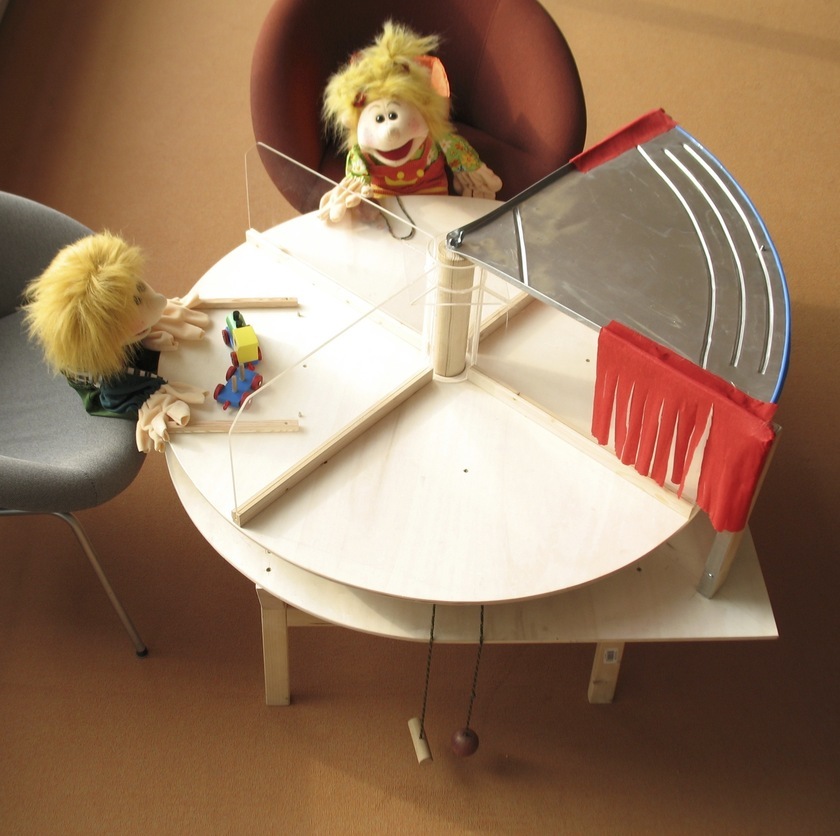

Even toddlers can distinguish between perpetrators and victims, even if these are puppets: they take objects away from a puppet that the latter had "taken away " another from another doll.
© MPI f. Evolutionary Anthropology
Toddlers have a reputation for being stubborn, selfish, and incapable of sharing. But researchers from the Max Planck Institute for Evolutionary Anthropology in Leipzig (Germany) and the University of Manchester (UK) have found that children as young as three actually will show a surprising level of concern for others and an intuitive sense of restorative justice.
Young children prefer to return lost items to their rightful owners, the studies show. If for some reason that is not an option, young children will still prevent a third party from taking what does not belong to them. What is more, both three- and five-year-old children are just as likely to respond to the needs of another individual—even when that individual is a puppet—as they are to their own. The findings in young children from Germany offer new insight into the nature of justice itself, the researchers say.
“The chief implication is that a concern for others—empathy, for example—is a core component of a sense of justice,” says Keith Jensen of the University of Manchester. “This sense of justice based on harm to victims is likely to be central to human prosociality as well as punishment, both of which form the basis of uniquely human cooperation.”
In human society, cooperation is often encouraged by punishing free-riders. However, earlier studies have shown that chimpanzees do not punish cheaters unless they themselves have been harmed directly. One way to understand the roots of justice in human society is to study the early emergence of the trait in young children. Studies have shown that children are more likely to share with a puppet that helped another individual than with one who behaved badly. They also prefer to see punishment delivered to a doll that deserves it than one that does not. By the age of six, children will pay a price to punish fictional and real peers. Preschoolers can also be encouraged with threats of punishment to behave more generously.
To find out what motivates a sense of justice in young children, Katrin Riedl along with Jensen and their colleagues gave three- and five-year-olds at the Max Planck Institute for Evolutionary Anthropology the opportunity to take items away from a puppet that had “taken” them from another. Those children were as likely to intervene on behalf of a puppet “victim” as they were for themselves. When given a range of options, three-year-olds preferred to return an item than to remove it. “It appears that a sense of justice centered on harm caused to victims emerges early in childhood,” the researchers write.
The findings highlight the value of third-party interventions for human cooperation. They might also come in handy for parents and teachers of preschoolers. “The take-home message is that preschool children are sensitive to harm to others, and given a choice would rather restore things to help the victim than punish the perpetrator,” Jensen says. “Rather than punish children for wrong-doings or discuss the wrong-doings of others in punitive or perpetrator-focused ways, children might better understand harm done to the victim and restoration as the solution.”
Contact
Dr. Katrin Riedl
Max Planck Institute for Evolutionary Anthropology, Leipzig
Phone: +49 171 8510-810
Email: psych.katrin.riedl@gmail.com
Dr. Keith Jensen
University of Manchester
Phone: +44 740 1186-179
Email: keith.jensen@manchester.ac.uk
Sandra Jacob
Press and Public Relations
Max Planck Institute for Evolutionary Anthropology, Leipzig
Phone: +49 341 3550-122
Fax: +49 341 3550-119
Email: info@eva.mpg.de
Original publication
Katrin Riedl, Keith Jensen, Josep Call, Michael Tomasello
Restorative Justice in Children
Current Biology, 18 June 2015, DOI: 10.1016/j.cub.2015.05.014












